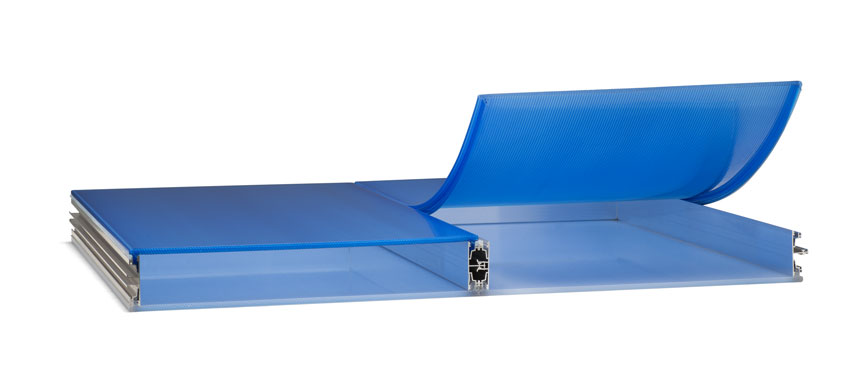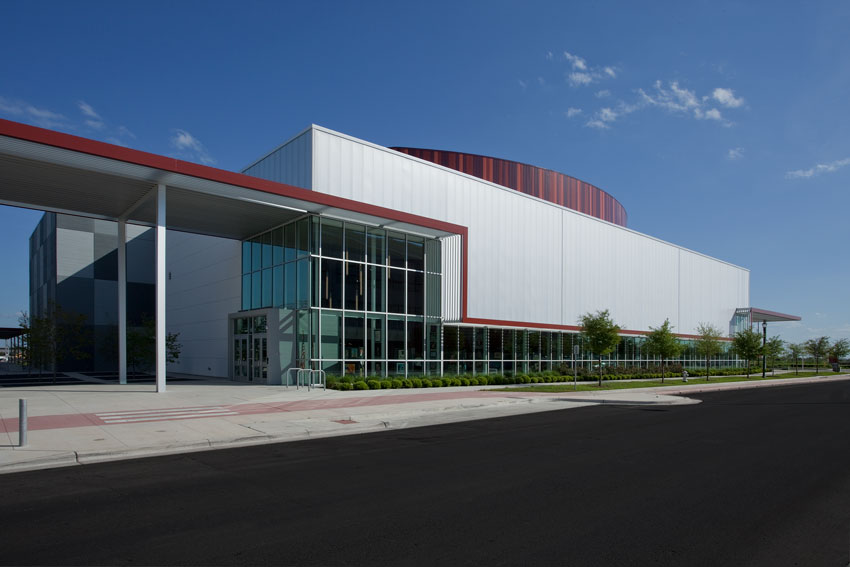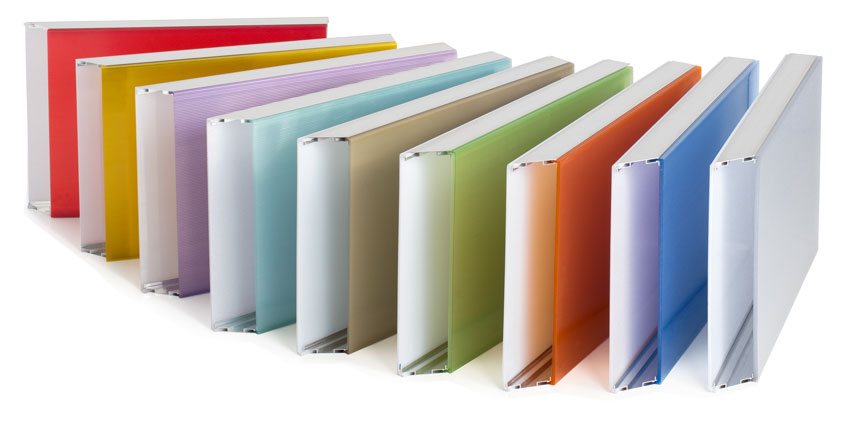Translucent Daylighting Facade Systems
Specialized Performance Options
In addition to the basic configurations of colored or insulated panels described above, there are also some other choices available that allow translucent panel systems to meet additional performance needs. For example, some of the techniques for insulation and tight construction that help with thermal performance also contribute to favorable acoustical control. Therefore, it is possible to ask for sound transmission class (STC) ratings on manufactured panels to help in buildings where noise is a concern. Similarly, facilities that have high security needs, such as military or government buildings, usually require a means to resist forced entry, and two-panel systems can be selected to satisfy this need.

Images courtesy of CPI Daylighting
An option for enhanced light control is the use of adjustable louvers that can be placed between the two layers of glazing.
One of the more advanced options for double-layered panels is the use of movable louvers located between the glazing layers. Selecting such a louvered system eliminates the need for exterior or interior shades or louvers but also allows for greater daylighting control. Referred to as “dynamic daylighting,” the louvers can manually or automatically adjust to control the amount of daylighting in several ways. First, as the sun moves throughout the day, the louvers can move to help reflect and direct light to where it is most wanted inside or deflect it to eliminate bright spots. Alternatively, the louvers can be set in a random or defined pattern to help further distribute and diffuse the sunlight. This can be particularly helpful on south-facing facades that receive a lot of direct sunlight. Finally, they can be used to shade or darken the space for times when the daylight is not needed, say for presentations or other activities. The specifics of how such a dynamic shading system work will be dependent on the specific system, so manufacturers should be consulted for details.
Operation and Maintenance Attributes
Most glazing systems need some type of maintenance, at least for routine cleaning. Occasionally, they also need attention due to wear or damage. In conventional glass systems and some other alternative systems, that usually means that part or all of the entire facade system may need to be removed, repaired, or replaced. By contrast, one of the features of the more advanced two-panel translucent systems is that they use a removable skin technology approach. This provides the flexibility to replace individual panels rather than the entire system. This can be particularly useful in cases where vandalism or severe conditions are anticipated to be an operations issue. Extra glazing panels can be stored at the facility and be readily used to replace damaged glazing whenever needed. Hence, each panel can be removed independently without removal of the entire system, allowing building operations to remain uninterrupted and without compromising the integrity of the building envelope. Removable skin technology also means that if there is a future need for updating the exterior, those panels can be changed without interrupting ongoing building operations.

Images courtesy of CPI Daylighting
Removable skin technology allows one of the polycarbonate glazing layers to be removed from the panel without impacting the other layer or the aluminum internal structure. Hence, repairs can be made without interrupting building operations.
Part of the reason the removable skin approach works is that it is based on a positive “dry” attachment of the glazing using gaskets that does not rely on sealants or adhesives. Rather, the glazing itself is formulated to be installed and locked into place in the aluminum support members of the unitized panel. This allows the free expansion and contraction of the glazing and aluminum components without compromising the panel joint. It also avoids possible delamination of the polycarbonate glazing from the internal support members.
Codes, Standards, and Translucent Glazing
Polycarbonate is an architectural-grade plastic material that is extremely durable, impact resistant, and shatterproof. Further, the internal aluminum supports provides spanning and deflection control capabilities based on the aluminum member sizing (i.e., approximately 3 or 4 inches deep). This combination of material strength and durability allows it to meet a full range of requirements in different codes and standards, including the deflection limitations of the International Building Code (IBC Table 1604.3), which call for a maximum deflection of L/120. Further, the two-panel system design helps to keep the building envelope sealed without any compromise on its integrity. That is because the interior panel is protected from exterior weather conditions, UV radiation, impact, and other hazards, and can remain fully intact for the life of the building.
For energy codes and standards, we have discussed how U-factor requirements can be achieved to meet minimum thermal performance as required in the IECC and verified by the NFRC. They can also be demonstrated to meet the requirements of the California Energy Code (Title 24). Moving from sustainability to resilience, these systems have been tested and shown to pass all requirements for Florida Product Approval and impact testing for High-Velocity Hurricane Zones (HVHZ). Similar certifications are available for the Texas Department of Insurance (TDI) wind programs. High-performance polycarbonate systems have also been tested to meet ASTM testing standards for smoke and fire requirements.
At the federal level, two-panel polycarbonate systems can also be used in applications that require Forced-Entry Protection or Anti-Terrorism Force Protection (ATFP). In locations that require it, they also can meet Occupational Safety and Health Administration (OSHA) requirements for fall through protection if used in skylights.
Note that it is important to keep in mind that there are different grades and qualities of polycarbonate and that not all will pass all tests or meet all needed standards. Therefore, consultation with manufacturers’ representatives and third-party product certification directories may be needed to verify which products are suitable for a given project.

© Bill Lemke
Project: ISD Performing Arts Center
Translucent two-panel polycarbonate building facades can be created with manufactured products that meet the requirements for building codes, energy codes, and voluntary standards such as LEED.
Green Building Contributions of Translucent Facades
We have discussed throughout this article numerous ways that two-panel translucent systems can contribute to green building design and construction. By way of tying those altogether, here is a quick summary based on the relevant categories in LEED:
- Energy and Atmosphere: As a primary part of the building facade, a full energy-performance model can be developed based on using the appropriate NFRC ratings for U-factor, solar heat gain coefficient, visible transmittance, and air leakage if available. Further, the coordination between using natural daylight and electrical lighting should be incorporated as part of the computer model for total energy performance.
- Materials and Resources: PPolycarbonate panels and the aluminum components can contain significant recycled content. Further, panels can be salvaged and reused in other buildings or recycled at the end of their service life. All of these attributes help to reduce their environmental impact as shown in a life-cycle assessment (LCA) or environmental product declaration (EPD).
- Indoor Environmental Quality: The addition of daylight is clearly the strongest contributor to this credit category, but by combining translucent and clear glazing, the facade can also provide appropriate views as well. Further, for systems that avoid sealants and adhesives, requirements for low-VOC-emitting materials can be met. This is carried through in the prefinished nature of the panels since no paints, coatings, adhesives, or sealants needed.
As part of an overall building design, then, high-performance translucent facade systems can be a significant part of achieving LEED certification or similar recognition.
Specifying Translucent Wall Systems
Specifications for translucent wall panel systems must be tailored to project needs but also with a clear understanding that not all systems are the same. Therefore, architects writing specifications for these systems need to be select from the appropriate differences and specific capabilities of the available manufactured products, thus making good spec writing critically important. Under the Master Format specification standard, these systems are normally found in Section 08.45.00 or related sections.
Under Part 1: General, in a standard three-part specification, the required performance standards should be listed for the products and system as a whole, including the NFRC100 and NFRC 400 testing standards for the thermal and light aspects of the system. Further, relevant ASTM standards for glare or “haze” (ASTM D1003) should be cited. For other code concerns, specify the needed ASTM standards for Self-Ignition Temperature (ASTM 1929-3), Smoke Density (ASTM D-2843), Burning Extent (ASTM D-635), and Interior Flame Spread (ASTM D-84). It may also be appropriate to cite ICC evaluation service report for compliance with IBC building code for polycarbonate glazing as an approved light transmission plastic with a CC1 rating per chapter 26, and class A interior finish glazing per chapter 8. Other standards can be cited for conditions relevant to the project, such as weathering, load-bearing capability, resilience, security, and sound transmission.

Image courtesy of CPI Daylighting
When specifying tight-celled polycarbonate glazing systems, it is important to select the color combinations for each location in the building.
Under Part 2: Products, there should be reference to a glazing schedule or other information on the drawings if multiple versions of glazed panels are being used so the locations in the building are clear. The specification should then go on to provide the details of each of the scheduled or identified glazing and frame products. All of the color selections and performance criteria of both the polycarbonate glazing and the metal materials should be identified and specified. Ideally, all materials should be specified to come from a single manufacturer as an integrated, coordinated, all-in-one glazing product.
In Part 3: Installation requirements, attention should be given to a preinstallation conference or meeting once the building structure is in place. This assures the opportunity for coordination between the general contractor and the trades involved in the proper installation of the translucent facade system. If possible, certified or trained installers of the system should be called for. Final placing, protecting, and cleaning in a manner consistent with manufacturer’s recommendations and standards will round out the specification.









